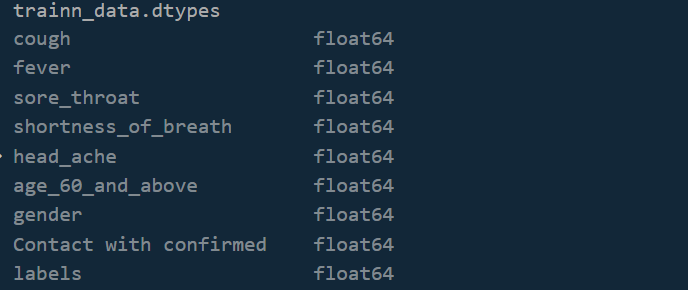DiCE
 DiCE copied to clipboard
DiCE copied to clipboard
DataFrame.dtypes for data must be int, float or bool. Error even if the data is float
the code was running fine last week but today as i try to run the same code i'm bumping into this issue/ Error:

even if the data is in float type .


and can't seem to fix this error .
anyone knows how to slove it ?
@ShadiKhoury If all your feature are continuous then why don't you specify them in the dicedata initialization?
can you try setting all your features as a python list in dicedata initialization?
Regards,
@ShadiKhoury does the above suggestion help you make progress on generating counterfactuals? If, so may be we can close this isssue.
Regards,
My features are all binary in a float format either 0.0 or 1.0 , even if I try to convert them all into int it still give’s the same error. And as I stated before this issue was not present when running DICE on the same data set , it’s new bug .
@ShadiKhoury can you share a sample dataset and notebook? Not sure we can help in triaging this issue without a local repro.
Regards,
def interpretation (trian_data,test_data,trian_labels,test_labels,model,feature_imprtance_type="dice_local_cf"):
#imports
import pandas as pd
import numpy as np
import math
import json
import plotly.graph_objs as go
from sklearn.linear_model import LogisticRegression
from sklearn.metrics import classification_report
from sklearn.preprocessing import OneHotEncoder
from sklearn.metrics import plot_roc_curve
from sklearn.model_selection import cross_val_score
import matplotlib.pyplot as plt
from sklearn.ensemble import RandomForestClassifier
from sklearn.model_selection import train_test_split
from sklearn.ensemble import GradientBoostingClassifier
from sklearn import preprocessing
from collections import Counter
import lightgbm as lgb
from sklearn.preprocessing import StandardScaler
from sklearn.ensemble import GradientBoostingClassifier
from sklearn.metrics import mean_squared_error,roc_auc_score,precision_score
pd.options.display.max_columns = 999
from sklearn.model_selection import train_test_split
from sklearn.preprocessing import label_binarize
from sklearn.metrics import roc_curve, auc
from sklearn.multiclass import OneVsRestClassifier
from itertools import cycle
plt.style.use('ggplot')
import dice_ml
from dice_ml.utils import helpers
from sklearn.metrics import precision_score, roc_auc_score, recall_score, confusion_matrix, roc_curve, precision_recall_curve, accuracy_score
# DiCE imports
import dice_ml
from dice_ml.utils import helpers
#########
#importing from CSV to Pandas
trian_data=pd.read_csv("%s" % trian_data);
test_data=pd.read_csv("%s"% test_data);
trian_labels=pd.read_csv("%s"% trian_labels);
test_labels=pd.read_csv("%s"% test_labels);
col_names=trian_data.columns;
# loop to change each column to float type
for col in col_names:
trian_data[col] = trian_data[col].astype('float',copy=False);
test_data[col]= test_data[col].astype('float',copy=False);
#selecting raws with no nan values
new_train=trian_data
new_train["Result"]=trian_labels
new_test=test_data
new_test["Result"]=test_labels
trian_data_nonull=new_train.dropna()
test_data_nonull=new_test.dropna()
trian_label_nonull=trian_data_nonull["Result"]
test_label_nonull=test_data_nonull["Result"]
trian_data_nonull.drop(labels = ["Result",], axis=1,inplace=True )
test_data_nonull.drop(labels = ["Result",], axis=1,inplace=True )
for col in col_names:
trian_data_nonull[col] = trian_data_nonull[col].astype('float',copy=False);
test_data_nonull[col]= test_data_nonull[col].astype('float',copy=False);
trian_data_nonull.reset_index(drop=True, inplace=True)
test_data_nonull.reset_index(drop=True, inplace=True)
#Scaling using the Standard Scaler
sc_1=StandardScaler();
X_1=pd.DataFrame(sc_1.fit_transform(trian_data_nonull));
X_train, X_val, y_train, y_val = train_test_split(X_1, trian_label_nonull, test_size=0.25, random_state=0) # 0.25 x 0.8 = 0
test_scale_data=pd.DataFrame(sc_1.fit_transform(test_data_nonull))
if model =="lgbm":
#Bulding them Model
lgbm_clf = lgb.LGBMClassifier(
num_leaves= 20,
min_data_in_leaf= 4,
feature_fraction= 0.2,
bagging_fraction=0.8,
bagging_freq=5,
learning_rate= 0.05,
verbose=1,
num_boost_round=603,
early_stopping_rounds=5,
metric="auc",
objective = 'binary',)
#Fitting the Model
lgbm_clf.fit(
X_train,
y_train,
eval_set = [(X_val, y_val)],
eval_metric="auc",
)
preds = lgbm_clf.predict_proba(test_scale_data,num_iteration=100)
predict_model=lgbm_clf;
#dice local with cf
if feature_imprtance_type=="dice_local_cf":
trainn_data=trian_data_nonull;
trainn_data["labels"]=trian_label_nonull
dicedata = dice_ml.Data(dataframe=trainn_data,continuous_features=[], outcome_name="labels")
# Using sklearn backend
m = dice_ml.Model(model=predict_model, backend="sklearn",model_type = 'classifier')
# Using method=random for generating CFs
exp_dice = dice_ml.Dice(dicedata, m, method="random")
query_instance=test_data_nonull[4:5];
e1 = exp_dice.generate_counterfactuals(query_instance, total_CFs=10,
desired_class="opposite",
verbose=False,
features_to_vary="all")
#Local Feature Importance Scores with Counterfactuals list
imp = exp_dice.local_feature_importance(query_instance, cf_examples_list=e1.cf_examples_list);
result = imp.local_importance[0].items()
# Convert object to a list
data_imp = list(result);
feature_imp1 = pd.DataFrame(sorted(data_imp), columns=['Feature','Value'])
importance_df_dice_local_cf=feature_imp1
importance_df_dice_local_cf.columns = ['name', 'importance'];
importance_df_dice_local_cf = importance_df_dice_local_cf.sort_values('importance', ascending=False)
#Ploting
importance_df_dice_local_cf.plot.barh(y="importance",x="name",color="#FF6103");
plt.gca().invert_yaxis()
plt.tight_layout()
plt.savefig("dice_local_cf_importance.pdf")
#plt.show()
#js_dice_lc_cf = importance_df_dice_local_cf.to_json(orient = "values")
#parsed_3 = json.loads(js_dice_lc_cf)
#Json
importance_dict_dicecflo = importance_df_dice_local_cf.set_index('name').T.to_dict('records')[0]
with open('Dice_local_cf_Feature_Importance.json', 'w') as outfile:
return json.dump(importance_dict_dicecflo,outfile)
Was this resolved?
@ShadiKhoury can you set continuous_features to all your train feature names in line dicedata = dice_ml.Data(dataframe=trainn_data,continuous_features=[], outcome_name="labels") can give another try?
when applying all continuous_features to all the features in my data set it worked like before 👍 . for now, it's okay but doesn't this defies the purpose of this input? as my features aren't continuous at all ?
Maybe a better name is "numeric_features", rather than continuous_features. Regardless, putting numeric features inside continuous_features fix should work for anyone facing this issue.